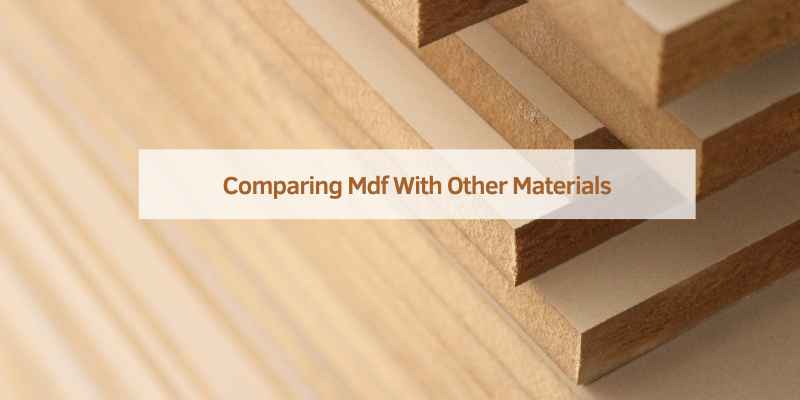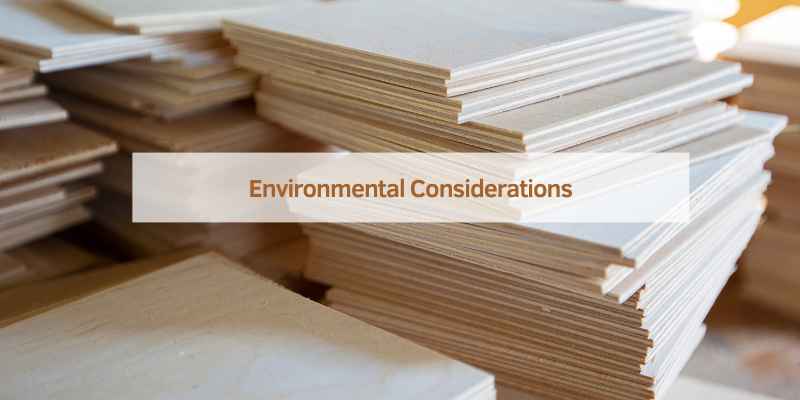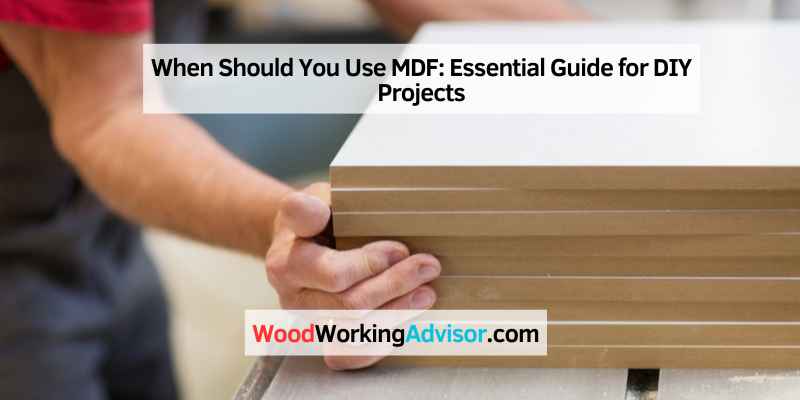Use MDF for indoor furniture, cabinetry, and decorative projects. It excels in smooth finishes and precise cuts.
Medium Density Fiberboard (MDF) is a versatile and affordable engineered wood product. It consists of wood fibers bonded with resin under high pressure. MDF is denser than plywood and offers a smooth surface, ideal for painting and laminating. Its uniform structure allows precise cutting and shaping, making it perfect for detailed projects.
MDF is also less likely to warp or crack compared to solid wood. Use MDF for indoor applications where moisture exposure is minimal. Avoid using it in high-humidity areas like bathrooms or basements. MDF’s affordability and ease of use make it a popular choice for DIY enthusiasts and professionals alike.
Comparing Mdf With Other Materials
MDF, or Medium-Density Fiberboard, is a popular choice for many woodworking projects. But how does it compare with other materials like solid wood and plywood? Understanding these differences helps you make the best choice for your needs.
Mdf Vs. Solid Wood
Solid wood is known for its strength and beauty. It’s a natural material that offers unique grain patterns and colors. MDF, on the other hand, is made from wood fibers glued together under high pressure.
Here is a comparison:
| Feature | Solid Wood | MDF |
|---|---|---|
| Strength | Very Strong | Moderate |
| Cost | Expensive | Affordable |
| Appearance | Natural | Uniform |
| Workability | Harder to Work With | Easy to Cut and Shape |
| Durability | High | Moderate |
Mdf Vs. Plywood
Plywood is another common material used in construction and furniture making. It consists of multiple layers of wood veneer glued together. MDF is different because it’s made from wood fibers.
Here is a comparison:
| Feature | Plywood | MDF |
|---|---|---|
| Strength | High | Moderate |
| Moisture Resistance | Good | Poor |
| Surface Smoothness | Varies | Very Smooth |
| Cost | Varies | Affordable |
| Workability | Chips Easily | Easy to Cut and Shape |
Pros And Cons
- Pros of MDF:
- Affordable
- Easy to Cut
- Uniform Surface
- Cons of MDF:
- Not Moisture Resistant
- Moderate Strength
- Heavier Than Plywood

Ideal Conditions For Using Mdf
MDF (Medium Density Fiberboard) is a versatile and cost-effective material. It is suitable for various projects, but it works best in specific conditions. Understanding the ideal conditions for using MDF can help you achieve the best results.
Indoor Applications
MDF is primarily designed for indoor use. Its smooth surface makes it perfect for indoor furniture, cabinetry, and shelving. MDF is easy to paint and finish, allowing for a high-quality look.
- Furniture: MDF is great for making tables, chairs, and desks.
- Cabinetry: Use MDF for kitchen cabinets and bathroom vanities.
- Shelving: MDF works well for bookshelves and storage units.
Using MDF indoors ensures longevity and maintains its appearance. Keep it away from windows and doors to avoid exposure to outdoor elements.
Low Moisture Environments
MDF is not suitable for areas with high humidity or moisture. Low moisture environments help maintain the integrity of the material. It prevents swelling and warping.
| Suitable Areas | Unsuitable Areas |
|---|---|
| Living rooms | Bathrooms |
| Bedrooms | Kitchens (near sinks) |
| Offices | Outdoor areas |
To ensure MDF lasts longer, always seal the edges and surfaces. This practice helps protect it from accidental spills and environmental moisture.
By using MDF in ideal conditions, you can maximize its benefits and enhance your projects’ durability and appearance.
Design Flexibility Of Mdf
Medium Density Fiberboard (MDF) is known for its incredible design flexibility. This engineered wood product is highly versatile, making it a popular choice for various applications. MDF is a preferred material for custom designs and intricate details.
Ease Of Cutting And Shaping
MDF is easy to cut and shape. Its smooth surface and consistent density allow for precise cuts and intricate designs. Compared to natural wood, MDF is less prone to splintering. This makes it ideal for detailed work.
Carpenters and DIY enthusiasts appreciate MDF’s workability. It can be cut into various shapes and sizes using standard woodworking tools. This flexibility makes MDF suitable for projects like custom cabinetry, furniture, and decorative panels.
Painting And Finishing Mdf
One of the standout features of MDF is its smooth surface. This makes it perfect for painting and finishing. The surface does not have knots or grain patterns, ensuring a uniform finish.
Before painting, it is essential to prime the MDF. Priming seals the surface and enhances paint adhesion. Once primed, MDF can be painted with any color. This allows for endless design possibilities.
For a more refined look, MDF can be finished with veneers or laminates. These finishes add both durability and aesthetic appeal to the final product.
| Feature | Benefit |
|---|---|
| Ease of Cutting | Allows for precise and intricate designs |
| Uniform Surface | Ensures a smooth and even finish |
| Versatility | Suitable for various applications |
Structural Projects And Mdf
MDF, or Medium-Density Fiberboard, is a popular building material. It’s made from wood fibers, resin, and wax. MDF is smooth and easy to cut. But is it good for structural projects?
Weight-bearing Considerations
MDF is not as strong as solid wood. It’s not ideal for structures that must bear heavy loads. MDF can bend or break under too much weight. Use MDF for projects where strength is not crucial.
| Material | Strength | Best Use |
|---|---|---|
| MDF | Medium | Cabinets, Shelves, Panels |
| Solid Wood | High | Furniture, Structural Beams |
Reinforcing Mdf
Reinforcing MDF can make it stronger. Adding braces or supports helps. Use MDF in a frame for better strength. Combine MDF with other materials for added durability.
- Use metal brackets.
- Add wooden supports.
- Glue layers of MDF together.
Reinforced MDF can hold more weight. Use it for larger shelves or panels. Reinforced MDF is still not as strong as solid wood.
Cost-effectiveness And Mdf
Medium Density Fiberboard (MDF) is a popular choice for many DIY projects. Its cost-effectiveness makes it a preferred material among homeowners and builders. MDF offers a budget-friendly alternative to solid wood without compromising on quality.
Budgeting Your Diy Project
When planning a DIY project, budgeting is crucial. MDF is significantly cheaper than solid wood. This makes it an excellent option for those on a tight budget.
Here’s a simple comparison table to show cost differences:
| Material | Average Cost per Square Foot |
|---|---|
| MDF | $1 – $3 |
| Solid Wood | $5 – $15 |
As seen, MDF costs less per square foot. This can free up your budget for other materials or tools.
Long-term Value
Though MDF is cheaper, it still offers long-term value. MDF is durable and can last for years with proper care. It is also resistant to warping and cracking, unlike solid wood.
Here are some key benefits of MDF:
- Durability: MDF can withstand daily wear and tear.
- Smooth Surface: Ideal for painting and finishing.
- Versatility: Easy to cut and shape for various projects.
These benefits ensure that MDF provides good value over time. It’s a smart choice for cost-effective, long-lasting DIY projects.
Safety Tips For Working With Mdf
Medium Density Fiberboard (MDF) is a popular material for building and crafting. But working with MDF requires some safety measures. This section covers essential safety tips for handling MDF.
Proper Ventilation
Always work in a well-ventilated area when cutting or sanding MDF. MDF can release harmful dust particles. These particles can be dangerous if inhaled.
- Open windows and doors to let fresh air in.
- Use an exhaust fan to remove dust from the workspace.
- Consider working outside if possible.
Personal Protective Equipment
Wearing the right protective gear is crucial. Always wear a dust mask or respirator to prevent inhaling harmful dust. Use safety goggles to protect your eyes.
| Equipment | Purpose |
|---|---|
| Dust Mask/Respirator | Prevents inhaling dust particles |
| Safety Goggles | Protects eyes from dust and debris |
| Gloves | Protects hands from splinters and chemicals |
Using ear protection is also a good idea. MDF can be very noisy when being cut or sanded.
- Wear earplugs or earmuffs.
- Ensure they fit well and are comfortable.
Lastly, wear long sleeves and pants. This will protect your skin from dust and sharp edges.
Advanced Diy Projects With Mdf
Medium Density Fiberboard (MDF) is a versatile material. It is perfect for advanced DIY projects. MDF is durable, smooth, and easy to work with. Let’s explore some exciting projects you can tackle with MDF.
Building Custom Furniture
Creating custom furniture with MDF is a fantastic idea. MDF is cost-effective and easy to cut. You can make shelves, tables, and cabinets.
- Shelves: MDF is excellent for building sturdy shelves. Its smooth surface is perfect for painting or veneering.
- Tables: You can design unique tables with MDF. It can be shaped and finished in various ways.
- Cabinets: MDF works well for cabinets. It provides a smooth surface for paint or laminate.
| Project | Benefits |
|---|---|
| Shelves | Sturdy, Smooth surface |
| Tables | Customizable, Easy to shape |
| Cabinets | Durable, Smooth finish |
Creating Decorative Elements
MDF is perfect for making decorative elements. It is easy to carve and shape. You can create wall panels, moldings, and intricate designs.
- Wall Panels: MDF is ideal for creating decorative wall panels. It is easy to paint and finish.
- Moldings: You can craft beautiful moldings with MDF. It is simple to cut and install.
- Intricate Designs: MDF can be used for intricate designs. Its smooth surface allows for detailed work.
Wall Panels
Easy to paint and finish
Moldings
Simple to cut and install
Intricate Designs
Allows for detailed work
Using MDF in advanced DIY projects opens up endless possibilities. Its ease of use and versatility make it a top choice for many enthusiasts.
Maintenance And Care Of Mdf Projects
Maintaining and caring for MDF projects ensures their longevity and appearance. MDF, or Medium Density Fiberboard, is a popular material used in various DIY and professional projects. Proper maintenance keeps your MDF projects looking new and extends their life.
Cleaning Tips
Regular cleaning helps maintain the beauty of your MDF projects. Here are some simple steps:
- Dusting: Use a soft, dry cloth to remove dust. Avoid using a damp cloth as MDF is sensitive to moisture.
- Stain Removal: For stubborn stains, use a mild detergent and a slightly damp cloth. Wipe gently to avoid damaging the surface.
- Polishing: Apply a light coat of furniture polish to protect the surface and add shine.
Repair And Touch-ups
Minor damages can be fixed easily. Here are some steps to help you:
- Filling Gaps: Use wood filler to fill small gaps or scratches. Sand the area smoothly once it dries.
- Edge Damage: For damaged edges, apply wood glue and clamp the pieces together until dry.
- Surface Refinishing: Sand the affected area lightly. Apply a fresh coat of paint or finish to restore its look.
Maintaining your MDF projects doesn’t have to be difficult. Regular cleaning and prompt repairs keep them in top condition.
Environmental Considerations
Environmental considerations are crucial when choosing construction materials. Medium Density Fiberboard (MDF) is popular for its versatility and cost-effectiveness. But how does it measure up environmentally? Let’s explore the sustainability, recycling, and disposal of MDF.
Sustainability Of Mdf
MDF is made from wood fibers and resin. It uses wood waste, making it a more sustainable option than solid wood.
Wood fibers are usually by-products from sawmills. This reduces the need for fresh timber and helps conserve forests.
Resin binds the fibers together. Manufacturers often use eco-friendly resins, reducing the environmental impact.
Using MDF supports sustainable forestry. It relies on recycled wood fibers, promoting the efficient use of resources.
Recycling And Disposal
Recycling MDF can be challenging. The resin used in its production complicates the recycling process.
Disposal of MDF must be managed properly. Improper disposal can release harmful chemicals into the environment.
Special facilities can handle MDF waste. They ensure that it is disposed of safely and responsibly.
Some companies offer recycling programs for MDF. They collect and recycle old MDF products, reducing landfill waste.
| Aspect | Details |
|---|---|
| Sustainability | Uses wood waste, eco-friendly resins, supports sustainable forestry |
| Recycling | Challenging due to resin, requires special facilities |
| Disposal | Must be managed properly, can release harmful chemicals |
Choosing MDF can be an environmentally friendly choice. It supports sustainable practices and efficient resource use.
Proper disposal and recycling are essential. They minimize the environmental impact and support a greener future.

Frequently Asked Questions
When Should You Not Use Mdf?
Do not use MDF in high-moisture areas like bathrooms or kitchens. Avoid it for outdoor projects or load-bearing structures. MDF isn’t suitable where durability and strength are crucial. It can swell and break easily when exposed to water.
What Is Mdf And When Would It Be Used?
MDF stands for Medium Density Fiberboard. It’s used in furniture, cabinetry, and interior paneling due to its smooth surface and durability.
What Is The Best Use Of Mdf?
The best use of MDF is for indoor furniture and cabinetry. It’s ideal for shelving, paneling, and moldings. Its smooth surface allows for easy painting and finishing. MDF is cost-effective and versatile, making it popular in home improvement projects.
What Is Mdf Most Commonly Used For?
MDF is most commonly used for furniture, cabinetry, and shelving. It’s also popular for molding, doors, and paneling.
Conclusion
Choosing MDF for your project depends on your specific needs. It’s ideal for smooth finishes and intricate designs. Always consider moisture exposure and weight requirements. MDF can be a cost-effective and versatile option. Make sure it suits the environment where it will be used.
Properly assess your project demands to decide wisely.


